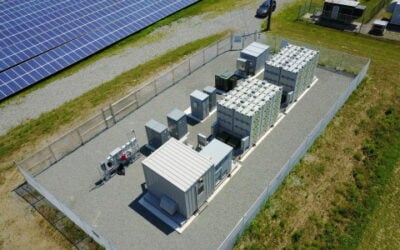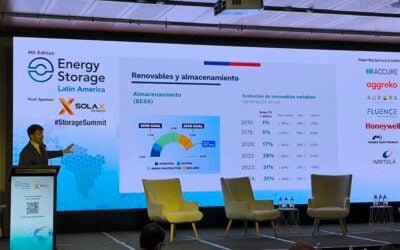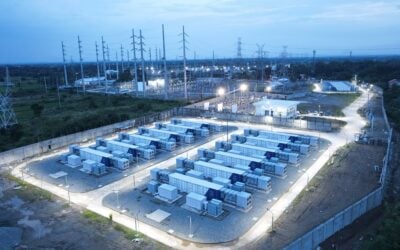
The US government’s Department of Energy (DoE) has described its just-published Energy Storage Grand Challenge Roadmap as its first comprehensive strategy on energy storage, identifying cost and performance targets to be met in the coming years.
The publication of the document follows the launch of the Energy Storage Grand Challenge (ESGC) by the DoE at the beginning of this year and the publication of a draft version of the new roadmap in summer. Among other things, it sets out a target for the levelised cost of long-duration energy storage to be reduced by 90% over the next nine years.
The ESGC looks to establish the US as a leader in energy storage and maintain that position; focusing not just on innovative new technologies and research into existing technologies but also on helping them traverse the fabled ‘Valley of Death’ that lies from lab to commercialisation. The Challenge also seeks to enable domestic manufacturing in the sector through secure supply chains.
The overarching goal of the ESGC is to develop and domestically manufacture energy storage technologies capable of meeting all of the needs of the US market by 2030 – a goal which the Department said in a press release is “aggressive but achievable”. The American energy storage industry should also be competitive internationally, including export opportunities, the DoE said.
Try Premium for just $1
- Full premium access for the first month at only $1
- Converts to an annual rate after 30 days unless cancelled
- Cancel anytime during the trial period
Premium Benefits
- Expert industry analysis and interviews
- Digital access to PV Tech Power journal
- Exclusive event discounts
Or get the full Premium subscription right away
Or continue reading this article for free
Around US$400 million per year has been invested into energy storage R&D by the Department over the last four fiscal years, but a comprehensive strategy has never been put in place, hence the introduction of the Grand Challenge.
Long-duration energy storage is crucial to help accelerate renewable energy deployment and integration onto the grid, Dr Imre Gyuk, director of the DoE’s research programme on energy storage, said at the Energy Storage Digital Series online event hosted earlier this year by our publisher Solar Media.
Dr Gyuk hosted the panel discussion session “Making a business case for long-duration energy storage” at the event, during which he said that while it may be essential from a technological standpoint, the regulatory frameworks to create market opportunities for longer duration energy storage technologies do not really exist, as yet.
The targeted reduction of the baseline cost of long-duration energy storage, aiming for a benchmark of US$0.05/kWh by 2030, means that it would become widely commercially viable for energy storage to be used for applications including meeting the grid’s load during peak demand periods, preparing the grid for electric vehicle (EV) fast-charging and ensuring the reliability of critical infrastructure.
Another of the key aims is creating a cost-competitive market for EVs. To achieve this, the strategy pinpoints a US$80/kWh manufactured cost benchmark for battery packs for EVs with a range of 300 miles, again by 2030. Current costs cited by the DoE are about US$143 per rated kWh, so a reduction of about 43% would be desirable. The DoE said that it also expects advances in battery production for transport applications will also continue to benefit the value chain of batteries used in stationary energy storage.
The Department’s ESGC will establish five separate “tracks” in what it described as its “holistic approach” to supporting energy storage in the US, from a Technology Development Track to support R&D around real-world applications, to a Manufacturing and Supply Chain Track, a Technology Transition Track to take new technologies into markets, a Policy and Valuation Track to support policy decisions and maximise the value of energy storage and educate the workforce through a WorkForce Development Track.
Energy Storage Association welcomes roadmap and “equally important” BEST Act legislation
The US national Energy Storage Association (ESA), which represents hundreds of diverse stakeholders across the industry welcomed the issuance of the roadmap earlier this week. The ESA called it a “well-delineated plan to accelerate the development, demonstration and deployment of energy storage”.
“By focusing storage valuation, supply chain and workforce matters as well as technology innovation, the roadmap provides wide-ranging context to guide federal funding and strategic decisions over the next 10 years,” the ESA said in a statement.
“It is critical that the Biden/Harris Administration continue to ensure that energy storage is central to a resilient, efficient, affordable, and sustainable power system, and also that we create new jobs and investment in the United States.”
ESA CEO Kelly Speakes-Backman recently told Energy-Storage.news that the group expects 2021 to be a big year for energy storage with a forecasted 3.6GW to be deployed in the US, while the ESA itself has a “vision” for 100GW of new grid storage to be deployed by 2030.
Also this week, a relief package to boost a national economy heavily-impacted by the coronavirus pandemic approved by Congress included a two-year extension of the solar Investment Tax Credit (ITC) for solar systems. As our sister site PV Tech reported yesterday, the legislation also includes the Better Energy Storage Technology (BEST) Act, authorising US$1 billion over five years for innovation investments in R&D and demonstrations for energy storage technology at a federal level.
ESA also welcomed the passage of the BEST Act as being “equally as important” as the publication of the ESGC roadmap. The Act will “provide a foundation for appropriations complimentary to DOE’s Roadmap,” once enacted, the Association said in its statement.
Introductions of a standalone energy storage tax credit scheme for deployment and manufacturing, as well as federal energy storage procurements and investments in energy storage to add resilience to US electricity networks are among further actions that the Biden Administration and Congress could take to “advance the goals of the Grand Challenge roadmap,” the ESA said.
The full Department of Energy ESCG roadmap can be viewed here.





